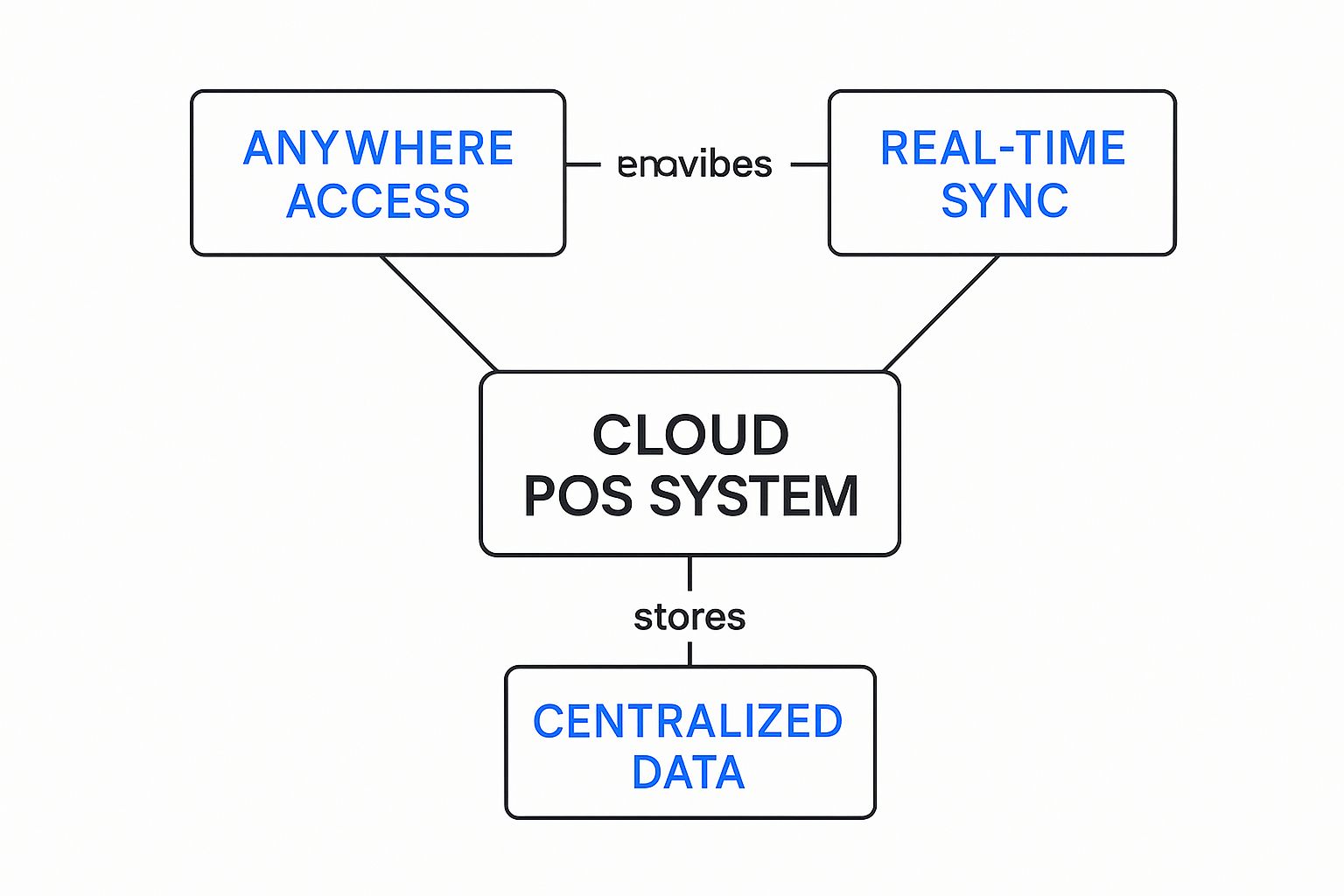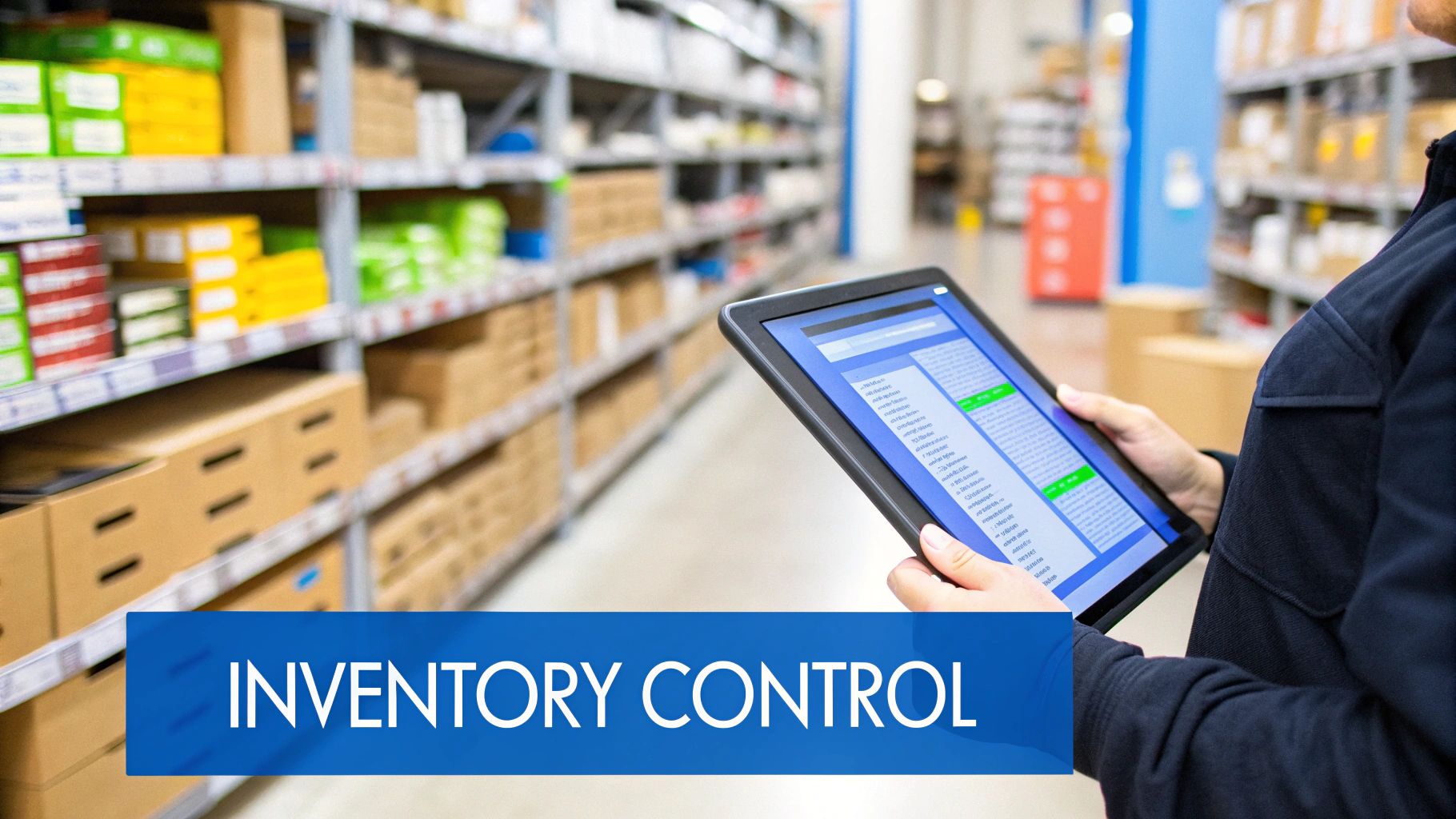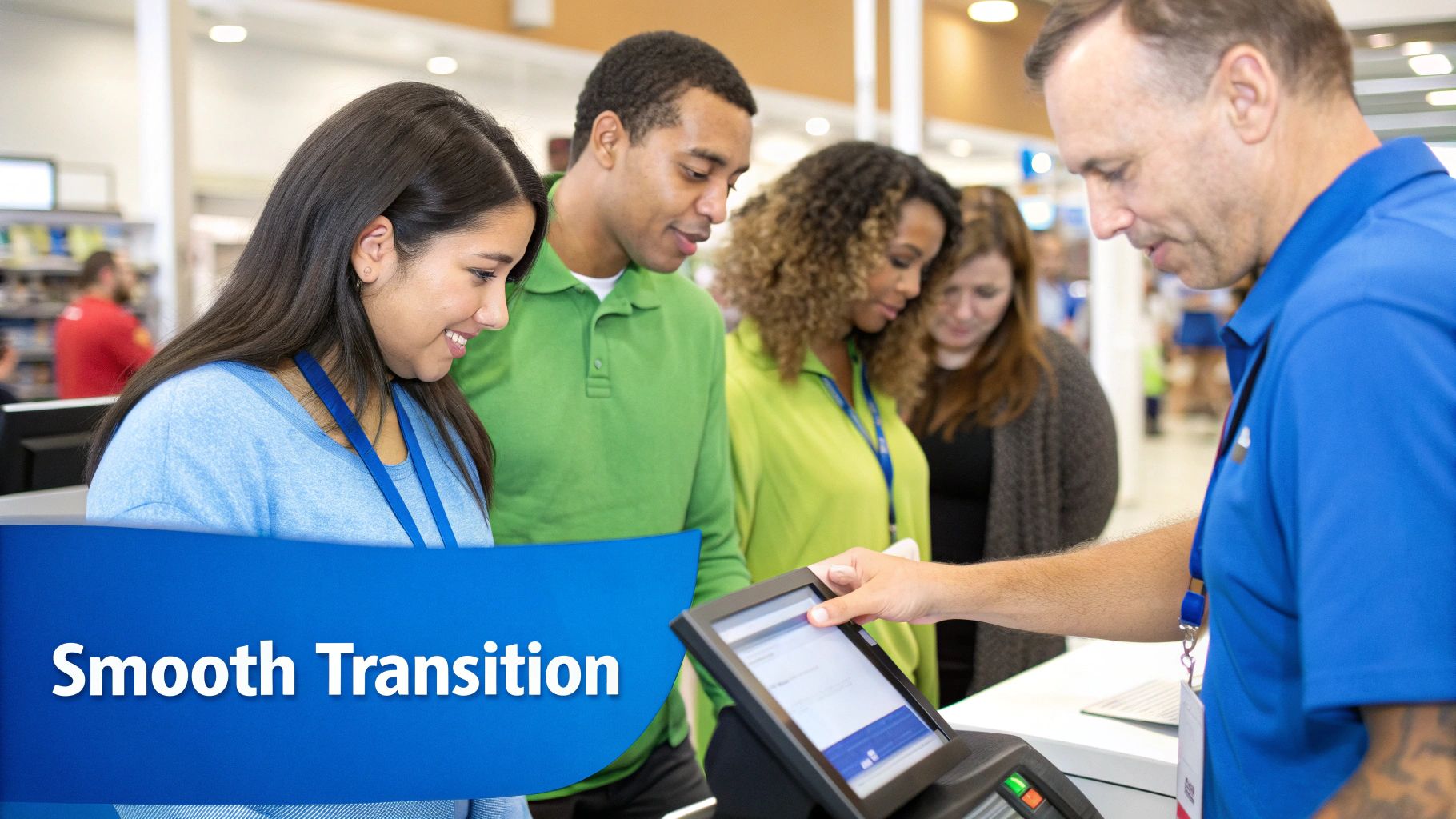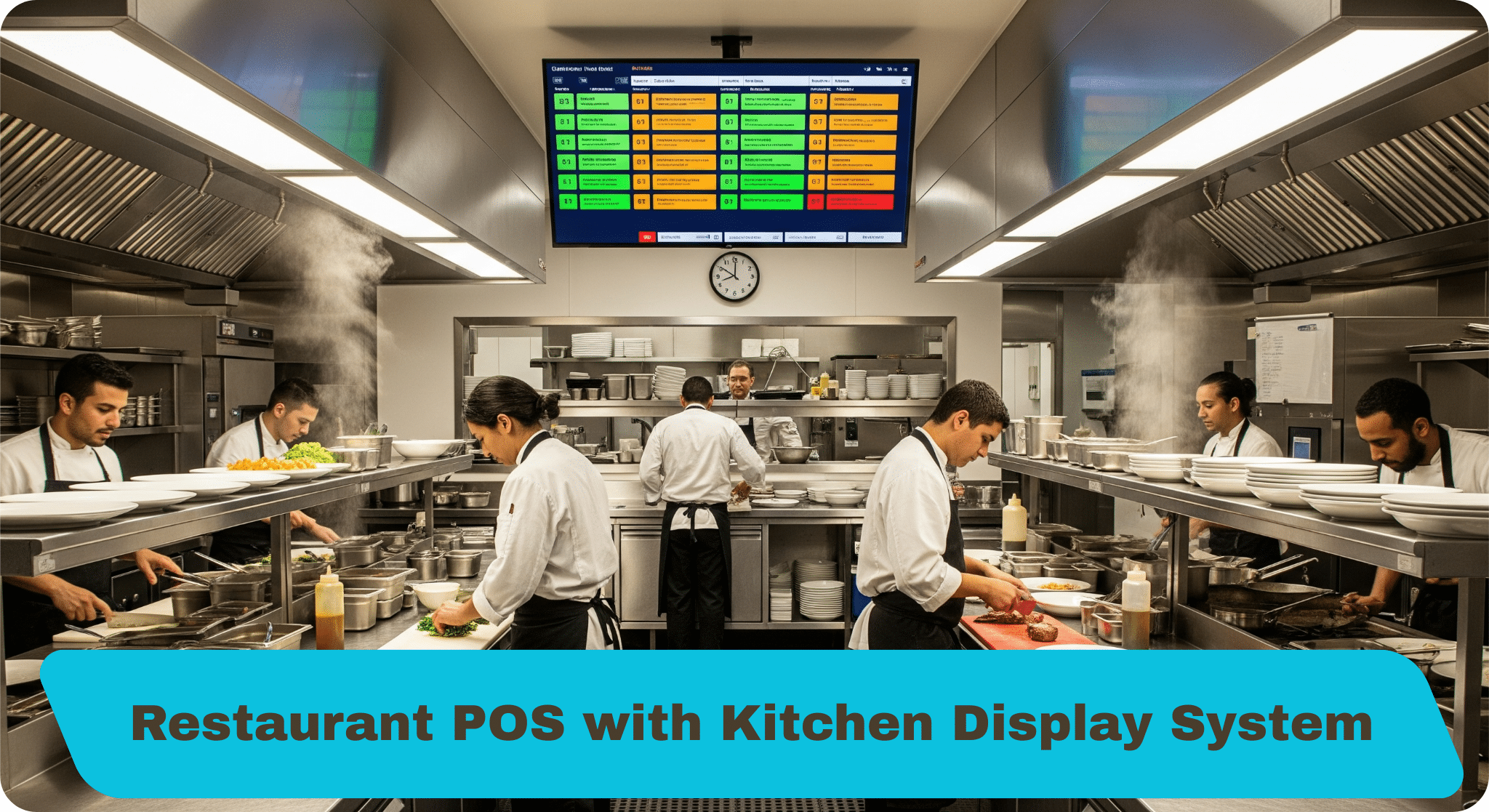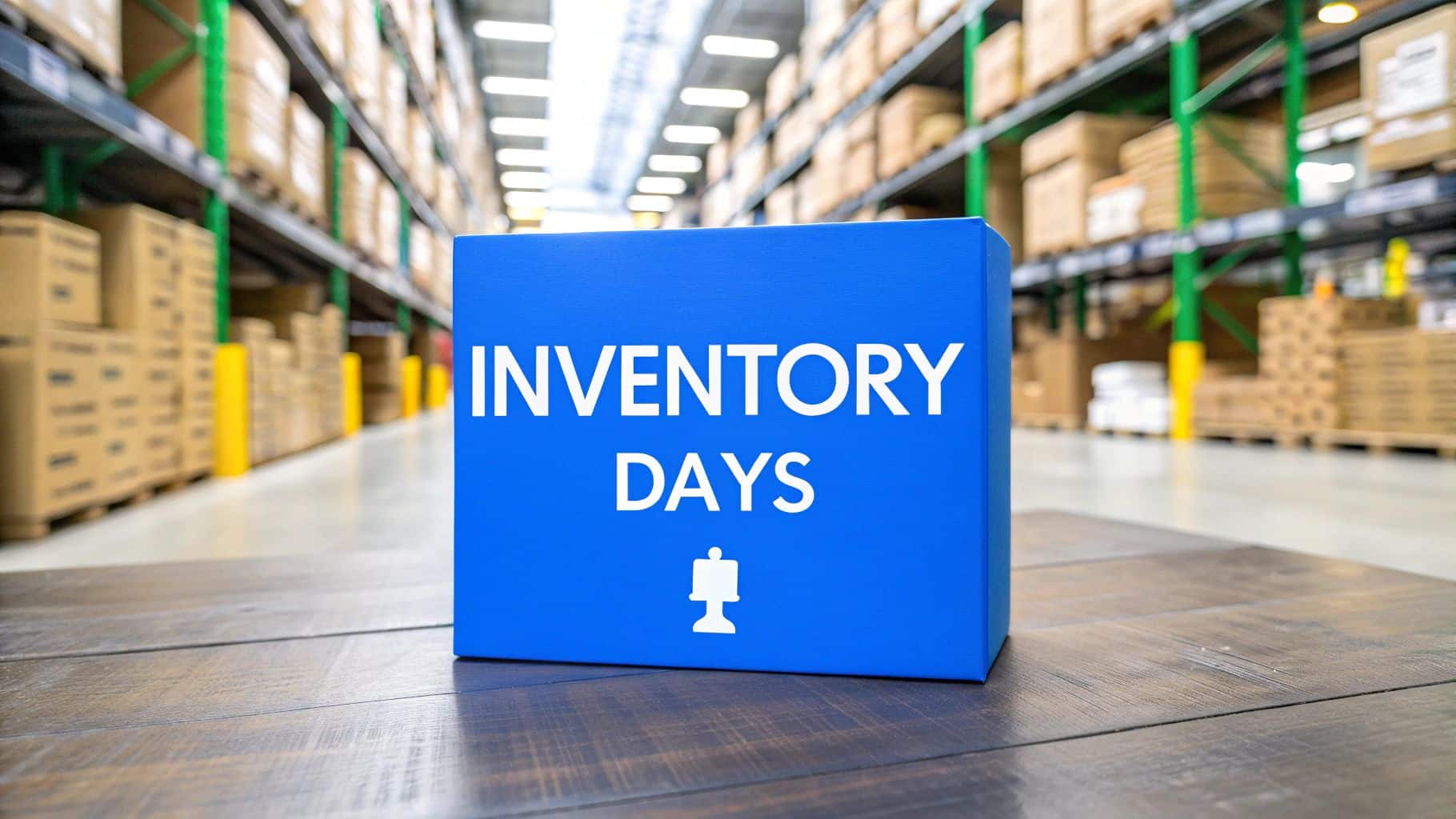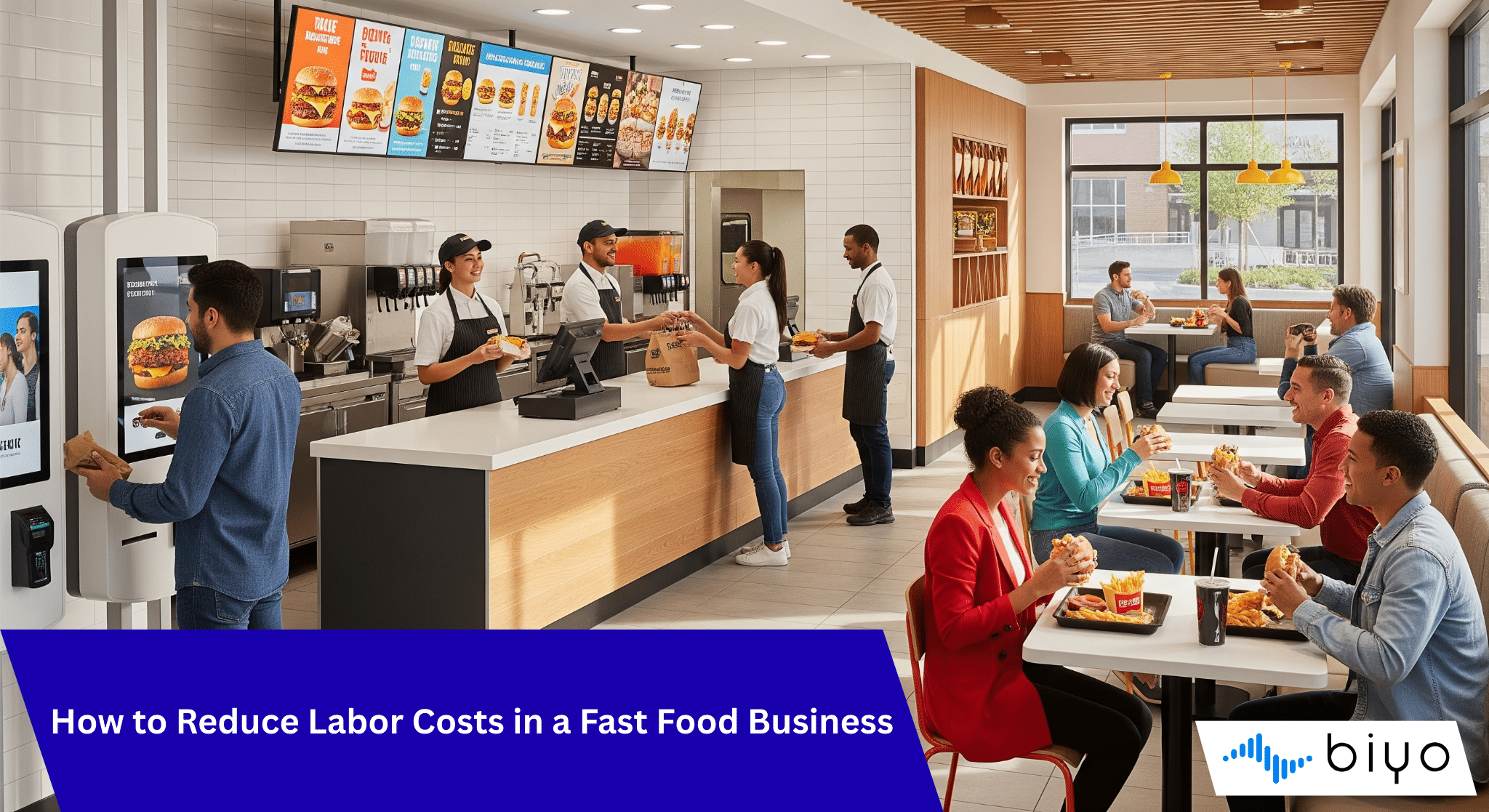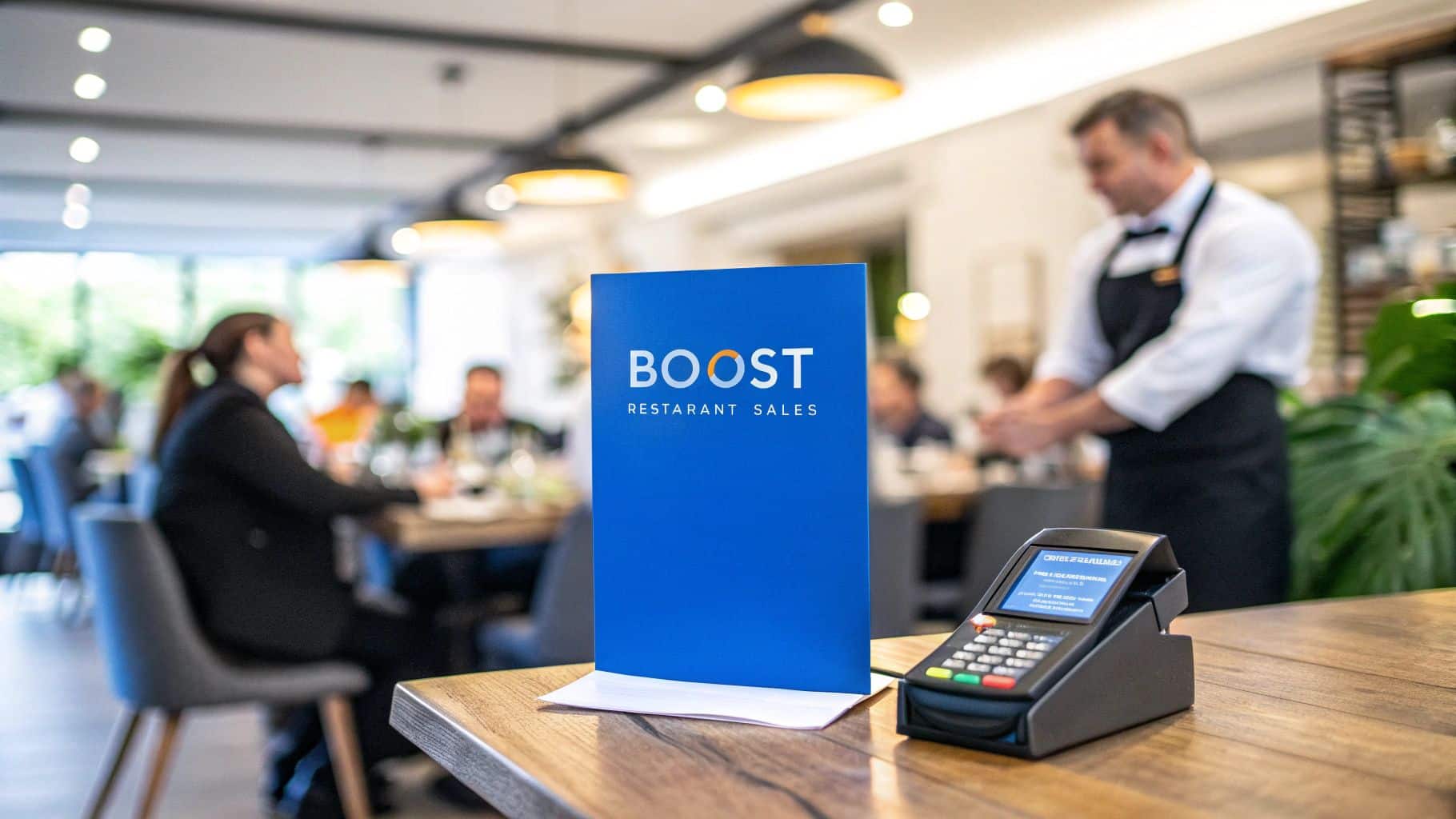A cloud based pos system is a point-of-sale solution that keeps your business data safe on remote internet servers instead of a local computer. Think of it like a streaming service for your business; instead of being tied to one device, you can pull up sales reports, check inventory, and view customer information from anywhere, on any device with an internet connection. This modern approach turns your checkout counter into a powerful, flexible hub for managing your entire operation.
Rethinking Your Point of Sale
It’s time to forget about those clunky, dusty servers humming away in the back office. A cloud based POS system completely untethers you from a fixed location. The entire system works by storing and processing your information online in a secure, centralized space. This is a huge leap from traditional systems that lock all your data onto a single, on-site computer, leaving it vulnerable to hardware failure and accessible only from that one machine.
To really get what this means for your business, it helps to see it as part of the bigger picture of top cloud services for small business. Just like cloud accounting software made bookkeeping easier and more accessible, a cloud POS changes how you handle the day-to-day reality of running your business.
The Core Concept Explained
At its heart, a cloud POS system runs on a Software as a Service (SaaS) model. This means you typically pay a manageable monthly subscription fee for access to the software, which includes all the updates, security patches, and support you’ll need. You can dive deeper into this model in our guide on Software as a Service (SaaS). Instead of a massive upfront cost for software licenses and expensive hardware, you get a solution that can scale right alongside your business.
This infographic breaks down the three pillars of a cloud POS system.
As you can see, the combination of anywhere access, real-time sync, and centralized data creates a single, powerful tool for managing your business from top to bottom.
A Shift In Business Management
Moving to the cloud isn't just a trend—it represents a real evolution in how businesses get things done. The market’s explosive growth tells the story. The global cloud POS market was valued at around USD 4.70 billion in 2023 and is expected to hit nearly USD 14.79 billion by 2030. That kind of growth shows a massive shift in the retail and hospitality worlds toward more nimble and efficient ways of operating.
Think of the difference between a DVD collection and a Netflix account. A traditional POS is like a DVD; it only works on one player, it can get scratched or lost, and you're stuck with the movies you own. A cloud POS is like Netflix; you can log in from any smart TV, tablet, or phone, your library is always updated with new content, and all your viewing history is safely stored for you.
This analogy really gets to the heart of the upgrade. You gain freedom, better security, and a system that continuously improves without you having to lift a finger. It’s all about turning your point of sale from a simple cash register into the central nervous system of your business—one you can access right from your pocket.
The Real-World Benefits of a Cloud POS Upgrade
Switching to a cloud-based POS system is more than just a tech refresh—it’s a strategic shift that brings real, tangible advantages to your daily operations. It changes everything from how you work to how you grow, impacting your flexibility, finances, and even the security of your business. The real magic isn't in the software itself, but in what it unlocks for you as a business owner.
Think about it: what if you could check your sales figures from your couch, update your menu while visiting a supplier, or manage staff schedules from anywhere in the world? That’s the kind of freedom we're talking about. A cloud POS untethers you from the physical storefront, turning business management into something you can do on the go.
Unlocking True Flexibility and Control
Remember when you had to be physically at your store to know what was going on? Those days are over. A modern cloud POS literally puts your entire business in the palm of your hand.
-
Work from Anywhere: You can keep an eye on live sales, see what's low in stock, and pull up customer history from any device with an internet connection. This is a game-changer for owners who juggle multiple locations or are just trying to reclaim a bit of work-life balance.
-
Real-Time Decision Making: Since all your data syncs to the cloud instantly, you can make smart decisions on the fly. See a product flying off the shelves? You can adjust your marketing right away. Notice a slow afternoon? You can launch a flash sale without ever stepping foot in the store.
This newfound agility means you’re always one step ahead, managing your business based on what’s happening right now—not what you read in an end-of-day report. It gives you a level of control that old-school legacy systems just can't match.
Significant and Ongoing Cost Savings
The financial perks of a cloud POS go far beyond the initial price tag. The traditional way of doing things involved a huge upfront investment in clunky servers, expensive software licenses, and ongoing IT support just to keep it all running.
A cloud POS flips this model on its head. Instead of owning and maintaining expensive hardware, you're essentially renting a sophisticated, always-on system. This shifts your costs from a large, unpredictable capital expense to a manageable and predictable operational expense.
Here’s where you’ll really see the savings pile up:
- No On-Site Servers: You can say goodbye to the cost of buying, storing, and maintaining a local server, which can easily run into thousands of dollars.
- Automatic Updates: Your provider rolls out software updates, security patches, and new features automatically and at no extra charge. No more paying for manual upgrades.
- Reduced IT Overhead: You won’t need to keep an IT person on speed dial or pay a third-party contractor just to manage your POS system.
This frees up cash that you can pour back into other areas of your business, like marketing or inventory. To learn more, check out these four key reasons to choose a cloud point of sale system.
Scalability and Enhanced Security
Maybe the biggest long-term advantage is how a cloud POS sets you up for the future. As your business grows, your POS grows right alongside you. Adding a new location, launching a pop-up shop, or even branching into e-commerce is a smooth, simple process. You won’t get stuck having to do a massive, costly system overhaul just because you’re successful.
At the same time, you’re essentially outsourcing your data security to the experts. Top cloud providers invest heavily in security measures—like advanced encryption and secure data centers—that most small businesses could never afford on their own. This protects your critical business and customer data from local disasters like hardware failure, theft, or even a fire. A modern system also gives you better tools for understanding and avoiding chargeback fees, adding another layer of protection to your bottom line.
Must-Have Features in a Modern Cloud POS System
When you start shopping for a cloud based pos system, it's easy to get lost in a sea of features. But to really move the needle for your business, you need to cut through the noise and focus on the core tools that will actually drive growth. Think of these as the non-negotiables—the features that turn a simple payment terminal into a true command center for your entire operation.
Without them, you’re just getting a fancy cash register. With them, you’re unlocking the ability to make smarter decisions, build real customer loyalty, and simplify the daily chaos of running a business. Let’s dive into what separates a basic POS from a genuine business-building powerhouse.
Real-Time Inventory Management
Poor inventory management is a silent killer. It either costs you sales when you run out of a popular item unexpectedly, or it ties up your cash in products that are gathering dust. A great cloud POS tackles this problem head-on with real-time inventory management.
Think of it as a stock manager who works 24/7. Every time an item is sold, returned, or received, your stock levels update instantly—not just at one register, but across every location and your online store. That synchronization is everything.
Key features to look for here include:
- Automatic Low-Stock Alerts: Get a heads-up the second an item hits a certain level, giving you plenty of time to reorder before you’re sold out.
- Purchase Order Creation: Build and send purchase orders straight from the POS, taking the headache out of restocking.
- Multi-Location Tracking: If you run multiple shops or have a warehouse, you can see exactly what you have and where, all from one dashboard.
This kind of control means you can keep your customers happy by always having what they want, right when they want it.
Integrated Customer Relationship Management
Your customers are the heart of your business, not just numbers on a sales report. A POS with a built-in Customer Relationship Management (CRM) tool helps you treat them that way, turning first-time visitors into regulars.
Instead of every transaction being anonymous, a CRM lets you attach a face and a history to each sale. You can build customer profiles that track what they buy, how often they visit, and what they love.
This functionality transforms your point of sale from a transactional device into a relational one. It's the digital equivalent of a classic shopkeeper who remembers every regular's name and favorite product, but scaled for the modern world.
With this info, you can create targeted email campaigns, set up loyalty programs that actually reward people for coming back, and offer the kind of personal touch that makes customers feel seen.
Detailed Sales Analytics and Reporting
Data is useless if you can’t make sense of it. The best cloud POS systems don’t just collect sales numbers; they translate them into clear, actionable insights through powerful sales analytics and reporting tools.
These features help you spot trends you might otherwise miss. You can quickly see which products are your top money-makers, what your busiest hours are, and how individual staff members are performing. For example, a café owner might use their reports to discover a new cold brew is outselling lattes 3-to-1, a clear sign to promote it more heavily.
Look for a system that lets you customize your dashboards so you can keep an eye on the numbers that are most important for hitting your goals.
Employee Management Tools
Your team is your biggest asset, and a solid cloud POS helps you manage them more effectively. Built-in employee management tools can handle everything from scheduling and time tracking to system security.
Crucial functions in this area are:
- Role-Based Permissions: You decide who gets to do what. Limit access to sensitive data or functions like processing refunds and viewing daily totals.
- Time Tracking: Staff can clock in and out right on the POS, which makes running payroll a whole lot easier.
- Performance Metrics: See sales data for each employee to celebrate your top performers and identify who might need a bit more coaching.
These tools don't just cut down on your admin work; they give you the insights to build a more efficient and motivated team. It’s no wonder that 41% of U.S. retailers have upgraded their POS systems specifically for better analytics and inventory features. You can discover more point-of-sale statistics here.
Seamless Software Integrations
Finally, your POS can't be an island. It needs to play well with the other software you depend on. Seamless integrations are the glue that connects your POS to the rest of your business tech.
This means your POS should talk directly to your accounting software (like QuickBooks), your e-commerce site (like WooCommerce), and your email marketing platform. This creates a single, unified system where data moves automatically, getting rid of mind-numbing manual entry and cutting down on costly mistakes. When all your tools are in sync, your entire business runs more smoothly.
How to Choose the Right Cloud POS for Your Business
Picking the right cloud-based POS system is a huge decision. It’s not just about taking payments; you're choosing the central command center for your entire operation—from sales and inventory to customers and staff. Getting this right from the start means investing in a tool that actually helps you grow, not one that holds you back.
Let's be honest, the ideal system for a busy restaurant is worlds away from what a small retail boutique needs. This guide will walk you through the process step-by-step, helping you tune out the marketing jargon and zero in on what truly matters for your business.
Map Out Your Specific Business Needs
Before you start looking at flashy demos, take a step back and think about what you really need your POS to do. Every industry has its own unique demands. By figuring yours out first, you'll create a simple checklist to measure every potential system against.
For example, a quick-service coffee shop thrives on speed. Their must-haves would be a super-intuitive ordering screen and seamless integration with delivery apps. A clothing store, on the other hand, cares way more about managing inventory with all its sizes and colors, plus a solid customer loyalty program to keep people coming back.
Your industry dictates your core feature set. Don't get distracted by features you'll never use. Focus on the tools that solve your biggest daily headaches, whether that's managing table layouts, tracking employee tips, or syncing inventory with your online store.
To give you a clearer picture, I've put together a quick table outlining the priorities for different types of businesses.
Cloud POS Needs by Business Type
This table breaks down the top features that different businesses typically look for in a POS system. Use it as a starting point to identify what's most critical for your own operations.
| Business Type | Top Priority Feature 1 | Top Priority Feature 2 | Top Priority Feature 3 |
|---|---|---|---|
| Restaurant/Cafe | Table Management & Floor Plans | Kitchen Display System (KDS) Integration | Online Ordering & Delivery Sync |
| Retail Shop | Advanced Inventory Tracking (Variants) | Integrated Loyalty Program & CRM | E-commerce Platform Integration |
| Bar/Nightclub | Fast Order Entry & Tab Management | Employee Permissions & Cash Tracking | ID Scanning & Age Verification |
| Service Business | Appointment Scheduling & Booking | Customer Database with History | Recurring Billing & Invoicing |
By knowing what to look for, you're already ahead of the game. Now you can evaluate potential systems based on your specific needs, not just a generic feature list.
Assess Hardware Compatibility and User Interface
Okay, you know what software features you need. Now it’s time to get practical. Your new POS software has to play nice with your hardware, whether it’s gear you already own or plan to buy. Check if the system works with standard equipment like iPads, Android tablets, receipt printers, and barcode scanners. Some companies lock you into their expensive, proprietary hardware, which can seriously drive up your startup costs.
Just as important is the user interface (UI). A clunky, confusing system slows everyone down, causes mistakes, and leaves customers tapping their feet in line. You want a design that’s clean and intuitive. Most companies offer free trials—put them to the test! Have your team try it out. If they can’t figure out a simple sale or return in a few minutes, that’s a huge red flag.
Demystify Pricing Models and Support
Cloud POS pricing can feel a bit like smoke and mirrors. Most work on a monthly subscription, but the advertised price is rarely the full story. You need to dig in and understand the total cost of ownership.
Always ask these questions to avoid nasty surprises:
- What are the payment processing fees? Some systems force you to use their in-house processor. Others let you shop around for better rates. Compare them closely.
- Are there extra costs for more registers or locations? A good plan should grow with your business without costing a fortune.
- Do I have to pay extra for key integrations? Some platforms will nickel-and-dime you for connecting to essential tools like your accounting software or e-commerce site.
Finally, never underestimate the value of good customer support. When your system crashes during a Saturday lunch rush, an email response 24 hours later isn’t going to cut it. Look for providers that offer 24/7 live support over the phone or chat. Think of it this way: great support isn't a bonus feature; it's a lifeline for your business.
Planning a Smooth Transition to Your New System
Let’s be honest, switching your point-of-sale system can feel like a pretty big deal. But with a solid plan, what seems like a major headache can actually be a seamless upgrade for your business. The secret is breaking the entire process down into smaller, more manageable steps—from getting your data ready to getting your staff excited.
This approach makes sure you can hit the ground running with your new cloud-based POS system from day one, without ever missing a sale.
The whole point is to keep downtime to an absolute minimum and avoid any frustrating glitches that might impact your customers. With a clear roadmap, you can make the move confidently and ensure your team feels supported every step of the way.
Kicking Off Your Implementation Plan
The first thing on your to-do list is getting your digital house in order. This is all about migrating the critical business data from your old system into the new one. Think of it less as a simple data dump and more as a chance to do some spring cleaning, organizing your information for peak performance.
You'll want to start by focusing on these core data sets:
- Product Catalogs: Export every product, along with SKUs, pricing, descriptions, and current inventory counts. This is the perfect time to ditch any discontinued items and fix old mistakes.
- Customer Profiles: Move your entire customer database, including their contact details and purchase history. This information is gold for keeping your loyalty programs and marketing campaigns running smoothly.
- Supplier Information: Make sure all your vendor details make the trip over. This will keep your purchase ordering process from hitting a snag.
Prepping your data like this means you won't have to start from scratch. It builds a solid foundation for everything else to come.
Setting Up Hardware and Training Your Team
With your data squared away, it’s time to get the physical hardware up and running. Whether you're working with existing iPads and printers or unboxing shiny new gear, you need to get everything connected and configured. Run a few tests. Do card readers work? Are receipts printing clearly? Do barcode scanners register instantly?
The most critical element of a smooth transition isn't the technology—it's your team. A system is only as good as the people using it, so investing in thorough training is non-negotiable. Confident employees lead to happy customers and a faster checkout process.
Great training builds confidence and takes the stress out of change. Focus on hands-on practice that covers the daily grind: processing different payment types, managing returns, and closing out the register. For a deeper dive, you can find excellent specialized resources for point-of-sale software training that can really empower your staff.
Executing the Go-Live and Post-Launch Checklist
Timing is everything when it comes to the final switch. You’ll want to schedule your "go-live" for your absolute quietest period—think early on a weekday morning or even overnight. Some businesses will even run the new system in parallel with the old one for a day, just as a final safety net.
Once you’ve officially made the switch, the job isn't quite done. The first few days are all about fine-tuning the system so it fits your workflow like a glove. Your post-launch checklist should include:
- Customizing Reports: Set up the sales and inventory reports that give you the insights you actually need to track key business metrics.
- Configuring Employee Access: Create specific user roles and permissions to control who can do what, like issue discounts or process refunds.
- Gathering Feedback: Touch base with your staff regularly. Find out what's working, what isn't, and where a little extra training might help.
By following a structured game plan like this, you can ensure your new cloud POS doesn't just work—it works for you.
Where Commerce is Headed: The Future of Cloud POS
Choosing a cloud-based POS system isn't just about fixing today's headaches; it's about setting your business up to win tomorrow. The way people shop and buy is changing faster than ever, and your point-of-sale system needs to be more than a simple cash register. It has to be the agile, future-ready core of your entire operation.
This isn't just a local trend—it's happening everywhere. The Asia-Pacific region, for example, is expected to be the fastest-growing market for cloud POS, all thanks to a massive push toward digital tools. This shows a worldwide shift where small and medium businesses are grabbing onto cloud technology to not just survive, but thrive. You can dig into these global POS adoption trends to see just how quickly the ground is shifting.
AI and the End of Channel-Surfing
Artificial intelligence (AI) and machine learning have officially left the realm of sci-fi and landed squarely in the world of retail. A smart cloud POS uses AI to sift through your sales data, spotting patterns that help you predict what customers will want next with uncanny accuracy.
Think about it: you'll know exactly which products to stock up on before a big holiday, not because of a gut feeling, but because the data told you so. That same intelligence can help you create personalized marketing offers, sending the right promotion to the right customer based on what they’ve bought before.
A truly modern cloud POS is the central nervous system for your business. It connects your brick-and-mortar store, your e-commerce site, and your social media shops into one unified, seamless customer experience.
This is what a real omnichannel setup looks like. A customer could discover a product on your Instagram, add it to their cart on your website from their laptop, and then pop into your store to pick it up—with every step tracked in one cohesive system. It's that kind of smooth, effortless journey that builds real loyalty. Trying to pull that off without a cloud-based hub is a logistical nightmare.
Keeping Up with How People Pay
The days of "cash or credit?" are long gone. Customers now expect to pay with everything from digital wallets like Apple Pay and Google Pay to QR codes and other tap-to-pay options. Old, clunky systems just can't keep up, leading to awkward workarounds or, even worse, lost sales.
A modern cloud-based POS system is built for this new reality. It’s designed to easily integrate new payment methods as they become popular, so you can always give the customer a confident "yes" when they're ready to buy. This isn't just about a faster checkout; it tells your customers that your business is current, convenient, and ready for whatever comes next.
Got Questions About Cloud POS Systems?
It's smart to have questions. Moving your business's core operations to a new system is a big deal, and a cloud-based POS system is a fundamental change from the old way of doing things. Let's tackle some of the most common concerns I hear from business owners just like you.
Getting straight answers will help you see past the tech jargon and understand how these tools solve real problems, from a spotty internet connection to keeping your data safe.
What Happens If My Internet Goes Down?
This is usually the first question on everyone's mind, and for a good reason. The good news is that any decent cloud POS is built for the real world, and that means it has a solid offline mode.
Even if your Wi-Fi cuts out, you can keep ringing up sales and taking credit card payments without skipping a beat. The system simply saves all the transaction information right there on your tablet or terminal. As soon as you're back online, it automatically syncs everything up to the cloud. No lost sales, no data headaches.
Is My Business Data Secure in the Cloud?
Absolutely. It’s actually a common misconception that keeping data on-site is safer. In reality, your information is far more secure with a reputable cloud provider than it would be on a computer in your back room. These companies use security protocols that are well beyond the budget of most small businesses.
Think of it like this: storing your data with a top cloud provider is like putting your money in a bank vault instead of keeping it under your mattress. The bank has advanced security, constant monitoring, and multiple layers of protection that you simply can't replicate at home.
Your data is typically protected by:
- Advanced Encryption: This scrambles your data, making it completely useless to anyone who shouldn't have access to it.
- Secure Data Centers: These are Fort Knox-level facilities with redundant power, climate control, and physical security.
- Regular Backups: Your information is automatically and constantly backed up, so you’re protected from everything from a spilled coffee on a laptop to a fire or theft.
Can I Use My Existing Hardware?
More often than not, yes. One of the best things about a cloud-based POS system is its flexibility. Most are designed to work with standard, off-the-shelf hardware like iPads, Android tablets, receipt printers, and barcode scanners you might already have. This can save you a significant amount of money upfront.
Before you sign on the dotted line, though, double-check. Every POS company will have a list of compatible hardware. A quick look at that list can prevent a lot of headaches and unexpected expenses later on.
How Much Does a Cloud POS System Cost?
Most cloud POS systems operate on a monthly subscription plan, what you'll often see called SaaS (Software as a Service). These plans can run anywhere from $50 to over $300 per month. What you'll actually pay depends on a few things: the features you need, the number of registers you're running, and whether you have multiple locations.
The monthly software fee is just one piece of the puzzle. You also need to ask about payment processing rates. Some POS providers have their own built-in processing, while others let you shop around for your own. Always ask for a clear breakdown of all costs—including any one-time setup or hardware fees—so you know the true total investment.
Ready to see how a modern POS can transform your operations? Biyo POS offers an all-in-one solution with features tailored for your business, from advanced inventory to seamless payment processing. Start your 14-day free trial today!

